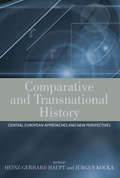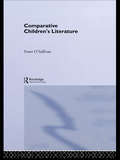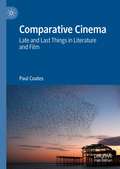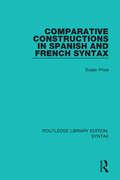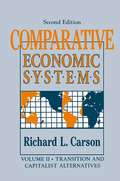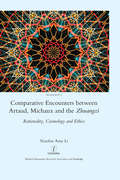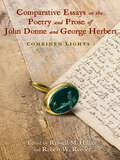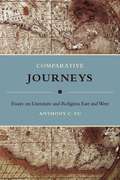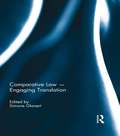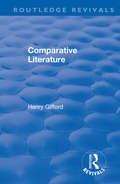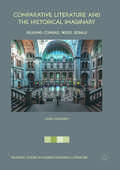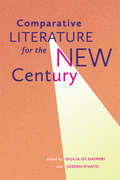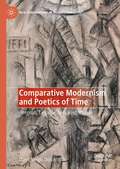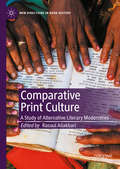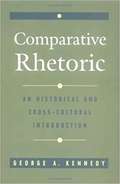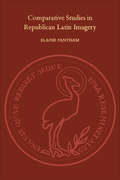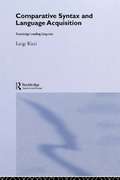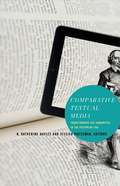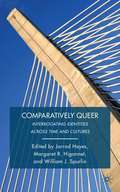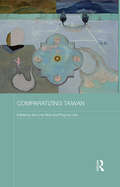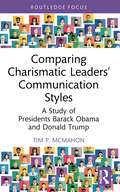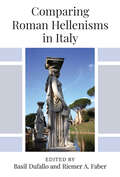- Table View
- List View
Comparative And Transnational History: Central European Approaches and New Perspectives
by Heinz-Gerhard Haupt Jurgen KockaSince the 1970s West German historiography has been one of the main arenas of international comparative history. It has produced important empirical studies particularly in social history as well as methodological and theoretical reflections on comparative history. During the last twenty years however, this approach has felt pressure from two sources: cultural historical approaches, which stress microhistory and the construction of cultural transfer on the one hand, global history and transnational approaches with emphasis on connected history on the other. This volume introduces the reader to some of the major methodological debates and to recent empirical research of German historians, who do comparative and transnational work.
Comparative Children's Literature
by Emer O'SullivanWINNER OF THE 2007 CHLA BOOK AWARD! Children's literature has transcended linguistic and cultural borders since books and magazines for young readers were first produced, with popular books translated throughout the world. Emer O'Sullivan traces the history of comparative children's literature studies, from the enthusiastic internationalism of the post-war period – which set out from the idea of a supra-national world republic of childhood – to modern comparative criticism. Drawing on the scholarship and children's literature of many cultures and languages, she outlines the constituent areas that structure the field, including contact and transfer studies, intertextuality studies, intermediality studies and image studies. In doing so, she provides the first comprehensive overview of this exciting new research area. Comparative Children's Literature also links the fields of narratology and translation studies, to develop an original and highly valuable communicative model of translation. Taking in issues of children's 'classics', the canon and world literature for children, Comparative Children's Literature reveals that this branch of literature is not as genuinely international as it is often fondly assumed to be and is essential reading for those interested in the consequences of globalization on children's literature and culture.
Comparative Cinema: Late and Last Things in Literature and Film
by Paul CoatesThis book comprises what may be called exercises in ‘comparative cinema’. Its focus on endings, near-endings and ‘late style’ is connected with the author’s argument that comparative criticism itself may constitute an endgame of criticism, arising at the moment at which societies or individuals relinquish primary adherence to one tradition or medium. The comparisons embrace different works and artistic media and primarily concern works of literature and film, though they also consider issues raised by the interrelationship of language and moving and still images, as well as inter- and intra-textuality. The works probed most fully are ones by Theo Angelopoulos, Ingmar Bergman, Harun Farocki, Theodor Fontane, Henry James, Krzysztof Kieślowski, Chang-dong Lee, Roman Polański, Thomas Pynchon, and Paul Schrader, while the key recurrent motifs are those of dusk, the horizon, the labyrinth, and the ruin.
Comparative Constructions in Spanish and French Syntax (Routledge Library Editions: Syntax #21)
by Susan PriceThis study, first published in 1990, presents a comprehensive description of the comparative constructions of Spanish and French, and shows that the apparently numerous differences in their syntactic realisations can be accounted for by general constraints on the expression of comparison. There is also a discussion of parallel constructions in other Romance languages, showing that these languages display a range of constructions equally compatible with the suggested pattern of possibilities resulting from the general constraints proposed. This title will be of interest to students of language and linguistics.
Comparative Economic Systems: Transition and Capitalist Alternatives (Comparative Economic Systems Ser. #Vol. I)
by Richard L. CarsonFirst Published in 2017. Routledge is an imprint of Taylor & Francis, an Informa company.
Comparative Encounters Between Artaud, Michaux and the Zhuangzi: Rationality, Cosmology and Ethics
by Xiaofan Amy Li"The encounter between different minds and perspectives across time and space has always haunted the literary and philosophical imagination. Just such an encounter is staged and played out in this comparative study, which connects the twentieth-century Francophone writers Antonin Artaud (1896-1948) and Henri Michaux (1899-1984) with the ancient Chinese text Zhuangzi (c. 4th-3rd century BCE). These disparate texts are bridged by questions that draw them into close dialogue: how can Artaud and Michaux, who read about and admired ancient Chinese literature and culture, be rethought through certain philosophical concerns that the Zhuangzi raises? If the points of conceptual intersection focus on rationality, cosmology and ethics, what can they tell us about these important issues? By imagining, constructing and developing this thought-encounter, Li re-envisages Artaud, Michaux and the Zhuangzi through the kaleidoscope of comparative interpretation, juxtaposing and recombining ideas and contexts to form new patterns and meanings. Xiaofan Amy Li is Junior Research Fellow in Comparative Literature and Translation at St Anne's College, Oxford University."
Comparative Essays on the Poetry and Prose of John Donne and George Herbert: Combined Lights
by Greg Miller Kimberly Johnson Helen Wilcox Kirsten Stirling Kate Narveson Angela Balla Anne-Marie Miller-Blaise Robert W. Reeder Danielle A. Hilaire Christopher T. HodgkinsThis book brings together ten essays on John Donne and George Herbert composed by an international group of scholars. The volume represents the first collection of its kind to draw close connections between these two distinguished early modern thinkers and poets who are justly couples because of their personal and artistic association. The contributors' distinctive new approaches and insights illuminate a variety of topics and fields while suggesting new directions that future study of Donne and Herbert might take. Some chapters explore concrete instances of collaboration or communication between Donne and Herbert, and others find fresh ways to contextualize the Donnean and Herbertian lyric, carefully setting the poetry alongside discourses of apophatic theology or early modern political theory, while still others link Herbert's verse to Donne's devotional prose. Several chapters establish specific theological and aesthetic grounds for comparison, considering Donne and Herbert's respective positions on religious assurance, comic sensibility, and virtuosity with poetic endings.
Comparative Journeys: Essays on Literature and Religion East and West
by Yu Anthony C.Throughout his academic career, Anthony C. Yu has employed a comparative approach to literary analysis that pays careful attention to the religious and philosophical elements of Chinese and Western texts. His mastery of both canons remains unmatched in the field, and his immense knowledge of the contexts that gave rise to each tradition supplies the foundations for ideal comparative scholarship. In these essays, Yu explores the overlap between literature and religion in Chinese and Western literature. He opens with a principal method for relating texts to religion and follows with several essays that apply this approach to single texts in discrete traditions: the Greek religion in Prometheus; Christian theology in Milton; ancient Chinese philosophical thought in Laozi; and Chinese religious syncretism in The Journey to the West. Yu's essays juxtapose Chinese and Western texts--Cratylus next to Xunzi, for example--and discuss their relationship to language and subjects, such as liberal Greek education against general education in China. He compares a specific Western text and religion to a specific Chinese text and religion. He considers the Divina Commedia in the context of Catholic theology alongside The Journey to the West as it relates to Chinese syncretism, united by the theme of pilgrimage. Yet Yu's focus isn't entirely tied to the classics. He also considers the struggle for human rights in China and how this topic relates to ancient Chinese social thought and modern notions of rights in the West. "In virtually every high-cultural system," Yu writes, "be it the Indic, the Islamic, the Sino-Japanese, or the Judeo--Christian, the literary tradition has developed in intimate--indeed, often intertwining-relation to religious thought, practice, institution, and symbolism." Comparative Journeys is a major step toward unraveling this complexity, revealing through the skilled observation of texts the extraordinary intimacy between two supposedly disparate languages and cultures.
Comparative Journeys: Essays on Literature and Religion East and West (Masters of Chinese Studies)
by Anthony YuThroughout his academic career, Anthony C. Yu has employed a comparative approach to literary analysis that pays careful attention to the religious and philosophical elements of Chinese and Western texts. His mastery of both canons remains unmatched in the field, and his immense knowledge of the contexts that gave rise to each tradition supplies the foundations for ideal comparative scholarship. In these essays, Yu explores the overlap between literature and religion in Chinese and Western literature. He opens with a principal method for relating texts to religion and follows with several essays that apply this approach to single texts in discrete traditions: the Greek religion in Prometheus; Christian theology in Milton; ancient Chinese philosophical thought in Laozi; and Chinese religious syncretism in The Journey to the West. Yu's essays juxtapose Chinese and Western texts-Cratylus next to Xunzi, for example-and discuss their relationship to language and subjects, such as liberal Greek education against general education in China. He compares a specific Western text and religion to a specific Chinese text and religion. He considers the Divina Commedia in the context of Catholic theology alongside The Journey to the West as it relates to Chinese syncretism, united by the theme of pilgrimage. Yet Yu's focus isn't entirely tied to the classics. He also considers the struggle for human rights in China and how this topic relates to ancient Chinese social thought and modern notions of rights in the West. "In virtually every high-cultural system," Yu writes, "be it the Indic, the Islamic, the Sino-Japanese, or the Judeo-Christian, the literary tradition has developed in intimate-indeed, often intertwining-relation to religious thought, practice, institution, and symbolism." Comparative Journeys is a major step toward unraveling this complexity, revealing through the skilled observation of texts the extraordinary intimacy between two supposedly disparate languages and cultures.
Comparative Law - Engaging Translation
by Simone GlanertIn an era marked by processes of economic, political and legal integration that are arguably unprecedented in their range and impact, the translation of law has assumed a significance which it would be hard to overstate. The following situations are typical. A French law school is teaching French law in the English language to foreign exchange students. Some US legal scholars are exploring the possibility of developing a generic or transnational constitutional law. German judges are referring to foreign law in a criminal case involving an honour killing committed in Germany with a view to ascertaining the relevance of religious prescriptions. European lawyers are actively working on the creation of a common private law to be translated into the 24 official languages of the European Union. Since 2004, the World Bank has been issuing reports ranking the attractiveness of different legal cultures for doing business. All these examples raise in one way or the other the matter of translation from a comparative legal perspective. However, in today’s globalised world where the need to communicate beyond borders arises constantly in different guises, many comparatists continue not to address the issue of translation. This edited collection of essays brings together leading scholars from various cultural and disciplinary backgrounds who draw on fields such as translation studies, linguistics, literary theory, history, philosophy or sociology with a view to promoting a heightened understanding of the complex translational implications pertaining to comparative law, understood both in its literal and metaphorical senses.
Comparative Literature (Routledge Revivals)
by Henry GiffordComparative Literature explores an 'area of interest' rather than a special discipline. The book begins with an account of the approaches that twentieth century writers took to literature by writers other than themselves. It discusses the common tone shared by those who subscribe to a national tradition, and considers what is meant by 'the mind of Europe'. It ponders the problems of translation, and discusses the nature of comparative study at university. Lastly, the special case of American literature is treated as pointing to the need for adjustment to a new stage in the world's culture. The criticial discussion of comparative studies provided in this book demonstrates the greater depth and vivacity that these studies can give to our ideas about literature.
Comparative Literature and the Historical Imaginary: Reading Conrad, Weiss, Sebald (Palgrave Studies in Modern European Literature)
by Kaisa KaakinenThis book argues that increasingly transnational reading contexts of the twenty-first century place new pressures on fundamental questions about how we read literary fiction. Prompted by the stylistic strategies of three European #65533;migr#65533; writers of the twentieth century -- Conrad, Weiss and Sebald -- it demonstrates the need to pose more differentiated questions about specific effects that occur when literary narratives meet a readership with a heterogeneous historical imaginary. In conversation with reception theory, trauma theory and transnational and postcolonial studies, the study shows how historical pressures in the twentieth and twenty-first centuries require comparative literature to address not only implied but also various unimplied reading positions that engage history in displaced yet material ways. This book opens new analytical paths for thinking about literary texts as media of historical imagination and conceiving relations between incommensurable historical events and contexts. Challenging overly global and overly local readings alike, the book presents a sophisticated contribution to discussions on how to reform the discipline of comparative literature in the twenty-first century.
Comparative Literature for the New Century
by Linda Hutcheon Giulia De Gasperi Joseph PivatoSince its beginning, Comparative Literature has been characterized as a discipline in crisis. But its shifting boundaries are its strength, allowing for collaboration and growth and illuminating a path forward. In Comparative Literature for the New Century a diverse group of scholars argue for a distinct North American approach to literary studies that includes the promotion of different languages. Chapters by senior scholars such as George Elliott Clarke, E.D. Blodgett, and Sneja Gunew are placed in dialogue with those by younger scholars, including Dominique Hétu, Maria Cristina Seccia, and Ndeye Fatou Ba. The writers, many of whom are multilingual, discuss problems with translation, identity and belonging, the modern epic, the role of tradition, minority writing, Francophone and Anglophone novels in Africa, and politics in literature. Engaging with theory, history, media studies, psychology, translation studies, post-colonial studies, and gender studies, chapters exemplify how the knowledge and tools offered by Comparative Literature can be applied in reading, exploring, and understanding not only literary productions but also the world at large. Presenting some of the most current work being carried out by academics and scholars actively engaged in the field in Canada and abroad, Comparative Literature for the New Century promotes the value of Comparative Literature as an interdisciplinary study and assesses future directions it might take. Contributors include George Elliott Clarke (University of Toronto), Dominique Hétu (Alberta & Montreal), Monique Tschofen (Ryerson), Jolene Armstrong (Athabasca), E.D. Blodgett (Alberta), Ndeye Fatou Ba (Ryerson), Maria Cristina Seccia (Hull), Sneja Gunew (UBC), Deborah Saidero (Udine), Elizabeth Dahab (CSULB), Gaetano Rando (Wollongong), Anna Pia De Luca (Udine), Mark A. McCutcheon (Athabasca), Giulia De Gasperi (PEI), and Joseph Pivato (Athabasca).
Comparative Modernism and Poetics of Time: Bergson, Tanpinar, Benjamin, Walser (New Comparisons in World Literature)
by Özen Nergis DolceroccaThis book explores the conceptualization of time in early twentieth-century literature and thought, based on a transnational and translational model of literary history, focusing on Turkish, French and German literary traditions. Each from different cultural backgrounds, these modernists provide a radical critique of modern time regimes, which calibrate time in singular temporal narratives. The book traces the philosophical strand of this critical chronometry from Henri Bergson’s theory of time, through Walter Benjamin’s ambivalence towards decay of tradition, and finally to A.H. Tanpınar and Robert Walser’s modernist fiction. Negotiating regionally marked concepts and topoi of temporality, it discusses networks of cultural circulations and maps a revised intersection of Turkish and Western European literary histories. It is an essential read for scholars and students of comparative and world literature, modernist studies, and cultural history.
Comparative Print Culture: A Study of Alternative Literary Modernities (New Directions in Book History)
by Rasoul AliakbariDrawing on comparative literary studies, postcolonial book history, and multiple, literary, and alternative modernities, this collection approaches the study of alternative literary modernities from the perspective ofcomparative print culture. The term comparative print culture designates a wide range of scholarly practices that discover, examine, document, and/or historicize various printed materials and their reproduction, circulation, and uses across genres, languages, media, and technologies, all within a comparative orientation. This book explores alternative literary modernities mostly by highlighting the distinct ways in which literary and cultural print modernities outside Europe evince the repurposing of European systems and cultures of print and further deconstruct their perceived universality.
Comparative Rhetoric: An Historical and Cross-Cultural Introduction
by George A. KennedyComparative Rhetoric is the first book to offer a cross-cultural overview of rhetoric as a universal feature of expression, composition, and communication. It begins with a theory of rhetoric as a form of mental and emotional energy which is transmitted from a speaker or writer to an audience or reader through a speech or text. In the first part of the book, George Kennedy explores analogies to human rhetoric in animal communication, possible rhetorical factors in the origin of human speech, and rhetorical conventions in traditionally oral societies in Australia, the South Pacific, Africa, and the Americas.<P><P> Topics discussed include forms of reasoning, the function of metaphor, and the forms and uses of formal language. The second part of the book provides an account of rhetoric as understood and practiced in early literate societies in the Near East, China, India, Greece, and Rome, identifying unique or unusual features of Western discourse in comparison to uses elsewhere. The concluding chapter summarizes the results of the study and evaluates the validity of traditional Western rhetorical concepts in describing non-Western rhetoric. Addressing both what is general or common in all rhetorical traditions and what is unique or unusual in the Western tradition, Comparative Rhetoric is ideally suited for courses in rhetoric, rhetoric theory, the history of rhetoric, intercultural communication, linguistic anthropology, and comparative linguistics.
Comparative Studies in Republican Latin Imagery
by Elaine FanthamOf all stylistic devices, imagery has the greatest appeal to the imagination, but is also the most likely to offend, either by staleness or by tasteless excess. This volume establishes some of the limitations which govern figurative language in Latin speech and prose by exploring such questions as these: From what physical or social contexts is Latin imagery derived? To what extent is it influenced by the primacy of Greek as a cultural language and the derivation of the earliest Latin literature from Greek models? How are the metaphors expressed in terms of syntax, through verb, noun, adjective, or a combination of syntactical forms? How are the form and content of imagery related to the literary genre? In this study Professor Fantham analyses in detail the conservative imagery of Terence and of Cicero's letters, contrasting this naturalistic language with the fantasies of Plautus and the formalization of Cicero's speeches. A separate chapter on the de Oratore shows how the thematic and structural use of metaphor and analogy provide balance and continuity, giving Latin prose imagery its full role in a mature classical work of art. Numerous illustrative passages from Greek New Comedy, Terence, Plautus, and Cicero are reproduced in the text.
Comparative Syntax and Language Acquisition (Routledge Leading Linguists #Vol. 7)
by Luigi RizziIn this collection of essays, the author addresses the central issues in syntax theory, comparative syntax and the theoretically conscious study of language acquisition. Key topics are explored, including the properties of null elements and the theory of parameters. Some of the essays presented here have been highly influential in their field, while others are published for the first time.
Comparative Textual Media: Transforming The Humanities In The Postprint Era
by N. Katherine Hayles Jessica PressmanFor the past few hundred years, Western cultures have relied on print. When writing was accomplished by a quill pen, inkpot, and paper, it was easy to imagine that writing was nothing more than a means by which writers could transfer their thoughts to readers. The proliferation of technical media in the latter half of the twentieth century has revealed that the relationship between writer and reader is not so simple. From telegraphs and typewriters to wire recorders and a sweeping array of digital computing devices, the complexities of communications technology have made mediality a central concern of the twenty-first century. Despite the attention given to the development of the media landscape, relatively little is being done in our academic institutions to adjust. <p><p> In Comparative Textual Media, editors N. Katherine Hayles and Jessica Pressman bring together an impressive range of essays from leading scholars to address the issue, among them Matthew Kirschenbaum on archiving in the digital era, Patricia Crain on the connection between a child's formation of self and the possession of a book, and Mark Marino exploring how to read a digital text not for content but for traces of its underlying code. Primarily arguing for seeing print as a medium along with the scroll, electronic literature, and computer games, this volume examines the potential transformations if academic departments embraced a media framework. Ultimately, Comparative Textual Media offers new insights that allow us to understand more deeply the implications of the choices we, and our institutions, are making.
Comparative Textual Media: Transforming the Humanities in the Postprint Era (Electronic Mediations)
by N. Katherine Hayles and Jessica PressmanFor the past few hundred years, Western cultures have relied on print. When writing was accomplished by a quill pen, inkpot, and paper, it was easy to imagine that writing was nothing more than a means by which writers could transfer their thoughts to readers. The proliferation of technical media in the latter half of the twentieth century has revealed that the relationship between writer and reader is not so simple. From telegraphs and typewriters to wire recorders and a sweeping array of digital computing devices, the complexities of communications technology have made mediality a central concern of the twenty-first century. Despite the attention given to the development of the media landscape, relatively little is being done in our academic institutions to adjust. In Comparative Textual Media, editors N. Katherine Hayles and Jessica Pressman bring together an impressive range of essays from leading scholars to address the issue, among them Matthew Kirschenbaum on archiving in the digital era, Patricia Crain on the connection between a child&’s formation of self and the possession of a book, and Mark Marino exploring how to read a digital text not for content but for traces of its underlying code. Primarily arguing for seeing print as a medium along with the scroll, electronic literature, and computer games, this volume examines the potential transformations if academic departments embraced a media framework. Ultimately, Comparative Textual Media offers new insights that allow us to understand more deeply the implications of the choices we, and our institutions, are making. Contributors: Stephanie Boluk, Vassar College; Jessica Brantley, Yale U; Patricia Crain, NYU; Adriana de Souza e Silva, North Carolina State U; Johanna Drucker, UCLA; Thomas Fulton, Rutgers U; Lisa Gitelman, New York U; William A. Johnson, Duke U; Matthew G. Kirschenbaum, U of Maryland; Patrick LeMieux; Mark C. Marino, U of Southern California; Rita Raley, U of California, Santa Barbara; John David Zuern, U of Hawai&‘i at Mānoa.
Comparatively Queer
by Jarrod Hayes Margaret R. Higonnet William J. SpurlinThese innovative essays take a comparative approach to queer studies while simultaneously queering the field of comparative literature, strengthening the interdisciplinary of both. The book focuses not only on comparative praxis, but also on interrogating our assumptions and categories of analysis.
Comparatizing Taiwan (Routledge Contemporary China Series)
by Ping-Hui Liao Shu-Mei ShihAs the site of crossings of colonizers, settlers, merchants, and goods, island nations such as Taiwan have seen a rich confluence of cultures, where peoples and languages were either forced to mix or did so voluntarily, due largely to colonial conquest and their crucial role in world economy. Through an examination of socio-cultural phenomena, Comparatizing Taiwan situates Taiwan globally, comparatively, and relationally to bring out the nation’s innate richness. This book examines Taiwan in relation to other islands, cultures, or nations in terms of culture, geography, history, politics, and economy. Comparisons include China, Korea, Canada, Hong Kong, Macau, Ireland, Malaysia, Japan, New Zealand, South Africa, the United States and the Caribbean, and these comparisons present a number of different issues, alongside a range of sometimes divergent implications. By exploring Taiwan’s many relationalities, material as well as symbolic, over a significant historical and geographical span, the contributors move to expand the horizons of Taiwan studies and reveal the valuable insights that can be obtained by viewing nations, societies and cultures in comparison. Through this process, the book offers crucial reflections on how to compare and how to study small nations. This truly interdisciplinary book will be welcomed by students and scholars interested in Taiwan studies, Sinophone studies, comparative cultural studies, postcolonial studies, and literary studies.
Comparing Charismatic Leaders’ Communication Styles: A Study of Presidents Barack Obama and Donald Trump (Routledge Focus on Communication Studies)
by Tim P. McMahonIn examining the presidencies of Barack Obama and Donald Trump, and by extension their communication styles, this book provides a foundation for understanding charismatic leadership and its potent effect on followers.The book identifies each leader’s charismatic leadership attributes, focusing specifically on communication and impression management. It presents a qualitative collection of leader observations and outcomes based on publications and audio and video recordings. By examining two distinctly different leaders, each with evidence of effective, if controversial, outcomes, it shows a spectrum of approaches to mobilizing followers.This book is suited to students and readers interested in leadership studies, leadership communication, and persuasion.
Comparing Roman Hellenisms in Italy
by Basil Dufallo Riemer A. FaberThe story of Roman Hellenism—defined as the imitation or adoption of something Greek by those subject to or operating under Roman power—begins not with Roman incursions into the Greek mainland, but in Italy, where our most plentiful and spectacular surviving evidence is concentrated. Think of the architecture of the Roman capital, the Campanian towns of Pompeii and Herculaneum buried by Vesuvius, and the Hellenic culture of the Etruscans. Perhaps “everybody knows” that Rome adapted Greek culture in a steadily more “sophisticated” way as its prosperity and might increased. This volume, however, argues that the assumption of smooth continuity, let alone steady “improvement,” in any aspect of Roman Hellenism can blind us to important aspects of what Roman Hellenism really is and how it functions in a given context. As the first book to focus on the comparison of Roman Hellenisms per se, Comparing Roman Hellenisms in Italy shows that such comparison is especially valuable in revealing how any singular instance of the phenomenon is situated and specific, and has its own life, trajectory, circumstances, and afterlife. Roman Hellenism is always a work in progress, is often strategic, often falls prey to being forgotten, decontextualized, or reread in later periods, and thus is in important senses contingent. Further, what we may broadly identify as a Roman Hellenism need not imply Rome as the only center of influence. Roman Hellenism is often decentralized, and depends strongly on local agents, aesthetics, and materials. With this in mind, the essays concentrate geographically on Italy to lend both focus and breadth to our topic, as well as to emphasize the complex interrelation of Hellenism at Rome with Rome’s surroundings. Because Hellenism, whether as practiced by Romans or Rome’s subjects, is in fact widely diffused across far-flung geographical regions, the final part of the collection gestures to this broader context.
